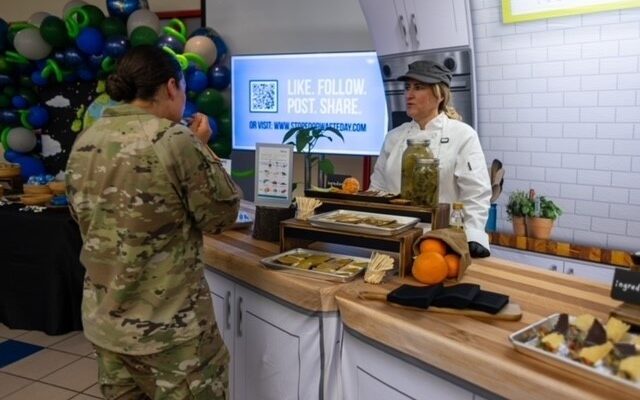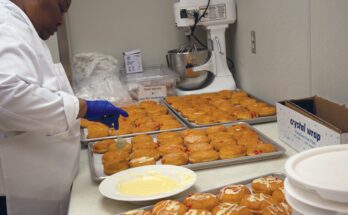REDSTONE ARSENAL, Ala. — A recent display of modern culinary practices mixed with old-school nutritional awareness brought Army leaders and industry experts together at Fort Liberty, North Carolina, to advance healthy dining initiatives based on feedback from Soldiers on where, when and how they want their meals.
The Army’s first Culinary Industry Day, April 25, 2024, saw more than 700 Soldiers and Family members receive meal prep guidance at teaching kitchens, advice on food security and budgetary coaching from financial readiness counselors, and the opportunity to provide feedback on different types of dining options used at colleges and universities.
“Industry has cracked the code on a lot of the things that we’re looking to implement within our food strategy, so we’re trying to bridge that gap,” said Sgt Maj. Kelvin Windham, Army Materiel Command G-4 sergeant major. “This allows us to see some of the innovative ways that industry is feeding their clientele. It’s important to see how they are doing campus-style dining at colleges and universities, because that’s primarily the same demographic of 18 to 24-year-olds that make up our essential station messing Soldiers on meal cards.”
Windham brings his expertise as a 92G culinary specialist to AMC’s Army Food Innovation and Transformation team that’s charged with the service’s line of effort under the food program strategy to provide healthy dining options for Soldiers and Families using industry best standards and practices. The A-FIT team partnered with the XVIII Airborne Corps to hold the Culinary Industry Day event at the corps’ Culinary Arts Readiness Training Center at Fort Liberty — a closed dining facility repurposed as a training area for 92Gs to enhance their food service skills.
The event allowed Army culinary representatives to better understand how industry was successfully attracting diners, given the utilization rate at some Warrior Restaurants sitting below 65%.
“At Columbia University, all the freshmen there have to be on the meal plan,” said Windham. “But when they become sophomores, they can then elect to not have the meal plan. What they’re seeing is, even that sophomores, juniors and seniors, they’re still having 95% of students elect to keep the meal plan. That’s impressive. There’s some goodness in there, so what are they doing right? This industry day is to bring some of the capabilities that industry is using and some of the best practices that they’re doing, so we can get some feedback from the Soldiers.”
One piece of equipment that was well received was similar to a vending machine in that patrons could make a selection and get a hot meal, said Windham.
“Some of the meals they had in this particular one included calzones, pasta, a jambalaya, and it takes 60 seconds and a hot meal pops out. It was amazing, especially because we’re looking at how do we meet Soldiers at the point of need with food that meets their schedules? And this machine could be a great way to do that.
“Another display was a food locker system,” he continued, “where Soldiers can digitally preorder meals, and you could potentially set this thing up in a barracks and work area anywhere. You can order a meal and it can be delivered and put into the food locker and the Soldier just goes and picks it up at the time that they had set. These are just a few of the things available that we could potentially look at getting with Soldier buy-in.”
“The meal lockers seem like a golden idea,” said Spc. Caleb Boggs, a culinary specialist/line cook with the 25th Quartermaster Company who said the event showed Soldiers alternatives beyond the Warrior Restaurant template. “This may not replace traditional sit-down cafeteria dining, however, my battle buddies and I could use a convenient option like this around the barracks and ranges.”
In addition to those flexible feeding options, Windham and Chief Warrant Officer 4 Shedrick Swain Jr., XVIII Airborne Corps command food advisor who set up the event locally, focused on a few other industry standards, such as marketing techniques, sourcing of food and ingredients and food preparation.
Industry reps used teaching kitchens to show participants how to follow recipes and prepare meals, said Windham, “as well as sharing a myriad of recipes on how to repurpose leftovers, which in turn can save a family a lot of money during the course of a month. It kind of showed those Soldiers and their Family members, hey, if you’re on a budget, these are some recipes you can cook to stay within your budget and this is how you can stretch meals out but still get that great nutritional value for you and your family.”
Cost savings were also addressed by Army financial counselors as Soldiers and Families went through the meal prep exhibit stations. In addition to the Army Community Service financial coaches, the Armed Forces Wellness Center had staff available to highlight proper nutrition.
“It’s important to educate on that nutrition piece along with food prep,” said Windham. “You know you can get a can of green beans and cook them for 30 minutes and you’ve probably cooked every nutrient out of that vegetable. It goes back to getting better ingredients and learning how to cook those ingredients the right way to help that Soldier’s nutritional value.”
Windham also praised the marketing side of the food industry in getting actionable feedback from their customers.
“They gave the culinary management noncommissioned officers a marketing class,” he said, “to show them this is how you can market your facility, everything from how you set up your serving line to the ambience inside of your Warrior Restaurant.
“So how do you get feedback? Are we just using surveys? Are we doing questionnaires? Are we doing focus groups? All of that was very important because we don’t get marketing taught to us as 92Gs. We don’t get that in any institutional training, so it was good to leverage industry in that digital space to better understand what Soldiers want.”
In addition to the digital space, the industry day event garnered plenty of immediate feedback.
“The most important thing that we took from being there is the feedback from Soldiers and their family members,” explained Windham. “Just getting that ground truth fidelity from the person that’s actually experiencing this — that’s invaluable. And what this industry day did, it helped us sit there with the Soldiers, ask them as they’re going through all these different stations — what are some of your challenges as a family? You know, a young family with three kids? What are your challenges as a Soldier living in the barracks in terms of how you’re fed, how you eat, how your food is sourced? Just getting that raw feedback, I think that was the biggest return on investment.”
Swain, who led the effort to make the event happen at Fort Liberty on short notice, agreed with the take-away: “The ultimate end state is to customize concepts across the food service landscape on Army installations with targeted approaches to satisfy a range of requirements, by meeting the needs of our Soldiers and their families with platforms and systems that are multiple in addressing needs.”
“Listening to those Soldiers and seeing them getting energetic and being happy about what the realm of possible is, and more importantly for them to see that Army leaders are invested in this was important,” added Windham. “They could see that their concerns are not falling on deaf ears. Army leaders are really crashing hard on this problem, and we’re going to revolutionize how we feed our soldiers. This day is just an example of how we are approaching it through industry partnership and innovation.”
Based on positive feedback from those attending, the AMC A-FIT team is reviewing the event offerings with plans to expand Culinary Industry Day to other installations in the future.



